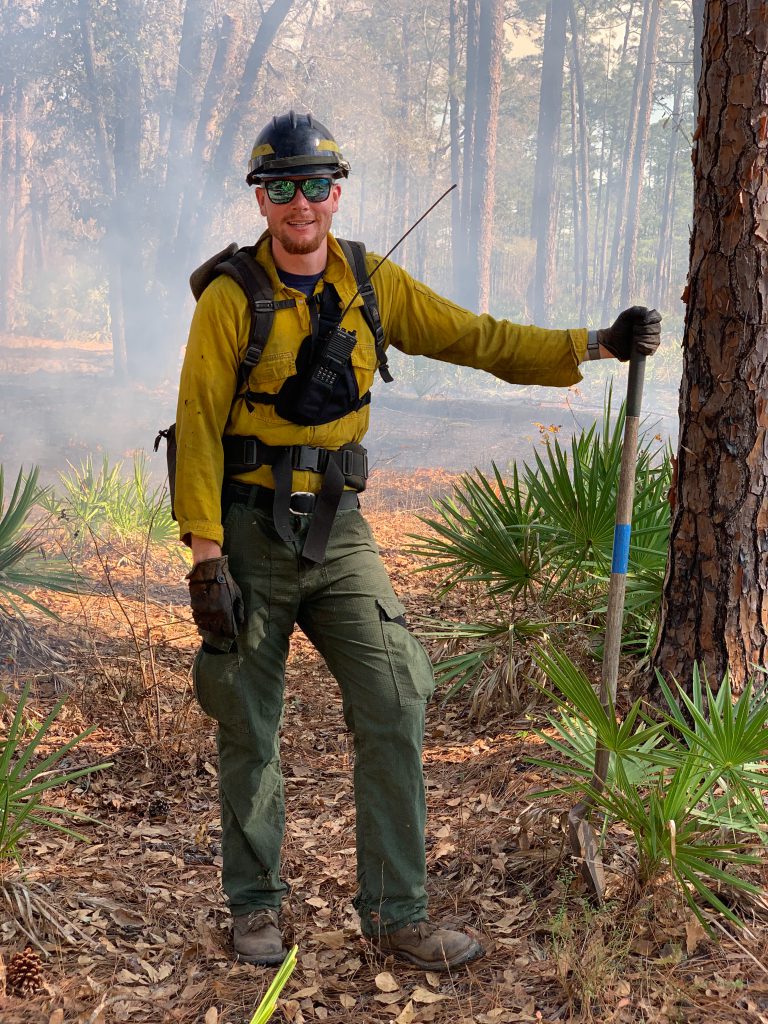In honor of Florida’s Prescribed Fire Awareness Week, we talked with UF/IFAS fire scientist Raelene Crandall about some of the critical tools of prescribed fire work: personal protective equipment, or PPE.
A former wildlands firefighter, Crandall is now an assistant professor in the UF/IFAS School of Forest, Fisheries, and Geomatics Sciences, where she teaches courses on the role of fire in managing natural resources. In these course, undergraduate students get hands-on experience in the field while wearing fire PPE.
“When it comes to the clothing and protective gear used by wildland firefighters, there is a lot more than first meets the eye,” Crandall said.
Why do you wear PPE when working with prescribed fire?
Everything we wear keeps us safe from the flames themselves and the hazards that come along with them. The kind of PPE we use in my classes is the industry standard.
Walk us through getting geared up for a fire—what are the different components?

When we’re on the fire line, we’re protected head to toe.
Head:
- A hard hat shields us from falling trees and debris, which are occasional hazards during a fire.
- Eye protection stops embers from getting in the eyes
- Some people wear a shroud that covers the nose, mouth and neck.
Hands:
- Well-fitting leather gloves ensure we get good grip on both big things like shovels and smaller things like the knobs on a drip torch.
Body:
- The outer layer is clothing made out of Nomex, a flame-resistant material. Some people wear a Nomex shirt and Nomex pants, others a full body suit those in the industry call a banana suit—most Nomex clothing is yellow, so that’s where the name probably comes from.
- Under the Nomex, we wear an all-cotton shirt and underwear, because synthetic fabrics could melt under the heat of the fire.
- On the chest, we wear a radio in a harness.
- We will also wear a backpack or belt that holds a lot of water, snacks, and a fire shelter. A fire shelter is a tent made of woven silica laminated to aluminum foil. It reflects the heat from fire and can be used in rare emergencies if you cannot escape.
Feet:
- Good cotton or wool socks.
- We wear special fire boots with soles made of Vibram, a material that insulates against heat and helps you better grip the ground. The rest of the boots are all leather with 6-inch uppers. This can lead to irritation on the front of the ankles known as “boot bite” and lots of blisters as you break them in.
How heavy is all that PPE?
Heavy! Especially the boots. My size 9 women’s fire boots weigh almost seven pounds total. Men’s boots can weigh nearly 10 pounds.
One of the tests any wildland firefighter has to pass involves walking 3 miles in 45 minutes wearing 45 pounds of gear. That gives you an idea of the endurance required.
What other item are always close at hand when managing a prescribed fire?
Water is extremely important. The work is strenuous, and when you add on the Florida heat, heat from the fire and the heavy clothing, the body loses water very quickly. Firefighters will usually carry about 8-10 pounds of water on them.
Each person must also carry an Incidence Response Pocket Guide. It is an essential reference that provides checklists, guidance, and decision tools that can and should be used on the fire line.
Does the gear need special care after use?
Any items made from Nomex need to be washed with water separately from any other clothing because you don’t want any flammable fibers possibly getting into the Nomex. The leather in our fire boots also needs special care and conditioning—but it you are diligent about caring for them, a good pair of fire boots can last a long time.
Source: UF/IFAS Pest Alert
Note: All images and contents are the property of UF/IFAS.



